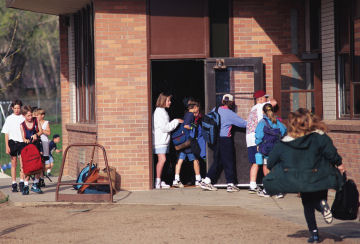No-Fight Zones: School programs reduce violence in all grades
As students head back to school this week, violence will follow a sizable number of them. Roughly 13 percent of public high school students report having had a fight on school property during the past school year. About 8 percent say that they were threatened or injured with a weapon at school, and 7 percent were bullied.

In some schools, however, a variety of violence-prevention programs have fostered substantial reductions in violent and disruptive behaviors, according to two new, independent research reviews. This positive effect occurs in all grades, from prekindergarten through high school, and in all schools, from the poorest to the wealthiest.
“These school-based programs improve learning and make the classroom a more peaceable kingdom,” says epidemiologist Robert A. Hahn of the Centers for Disease Control and Prevention in Atlanta.
The new reviews, published in the August American Journal of Preventive Medicine, counter assertions by some educators and researchers that violence-prevention programs pack little practical punch.
Hahn directed the first review, which assessed 53 studies of violence-prevention programs delivered to all children in a particular grade or school. Most of the studies were conducted within the past 20 years. The prevention programs were classroom based and conducted primarily by teachers or researchers.
The programs focused on various approaches, including problem-solving skills and emotion-control strategies, rewards for good behavior, conflict resolution, and peer mediation. Some programs provided individual or family counseling and parent-skill training.
On average, the programs led to a 15 percent reduction in violent and aggressive behavior, Hahn’s group found. Most studies charted this decline for 6 months after a program’s completion. A few longer studies noted that the programs’ violence-dampening effects had weakened slightly several years after completion.
Comparable findings emerged from a second, broader review. Sandra Jo Wilson and Mark W. Lipsey, psychologists at Vanderbilt University in Nashville, analyzed data from 249 studies of school-violence–prevention programs. Some of the programs had been delivered to all students. Others had been given to select students identified by teachers as disruptive or to students in special education classes.
The reviews overlapped in that Wilson and Lipsey’s analysis included about half of the programs evaluated by Hahn’s team.
The researchers found slightly greater declines in violence and aggression from programs designed for selected, “problem” students than from programs for all students. Both types of programs also promoted truancy declines and improved academic achievement, the reviewers report. Programs for special education students achieved smaller, but statistically significant, declines in violence rates.
Federal-government data suggest that about 20 percent of students engage in some sort of violent or disruptive behavior in a typical school year. Universal and select-student programs would, on average, reduce that proportion to around 15 percent and 13 percent, respectively, Wilson and Lipsey estimate.
The two new reviews offer encouraging news, even if they left critical questions unanswered, concludes criminologist Denise C. Gottfredson of the University of Maryland at College Park. For instance, she says, investigators need to examine more closely, and for longer periods, whether school-based programs lower criminal violence, such as assault and rape.